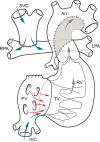Mechanical Circulatory Support for Single Ventricle Failure
- PMID: 30211172
- PMCID: PMC6122112
- DOI: 10.3389/fcvm.2018.00115
Mechanical Circulatory Support for Single Ventricle Failure
Abstract
Mechanical circulatory support (MCS) for failing single ventricle (SV) physiology is a complex and challenging problem, which has not yet been satisfactorily addressed. Advancements in surgical strategies and techniques along with intensive care management have substantially improved the outcomes of neonatal palliation for SV physiology, particularly for hypoplastic left heart syndrome (HLHS). This is associated with a steady increase in the number of SV patients who are susceptible to develop heart failure (HF) and would potentially require MCS at a certain stage in their palliation. We have reviewed the literature regarding the reported modalities of MCS use in the management of SV patients. This includes analysis of various devices and strategies used for failing circulation at distinct stages of the SV pathway: after neonatal palliation, after the superior cavo-pulmonary connection (SCPC), and after total cavo-pulmonary connection (TCPC).
Keywords: VA ECMO; fontan physiology; mechanical circulatory support; single ventricle; ventricular assist devices.
Figures
References
-
- Stanford W, Armstrong RG, Cline RE, King TD. Right atrium-pulmonary artery allograft for correction of tricuspid atresia. J Thorac Cardiovasc Surg. (1973) 66:105–11. - PubMed
-
- Kreutzer GO, Vargas FJ, Schlichter AJ, Laura JP, Suarez JC, Coronel AR, et al. . Atriopulmonary anastomosis. J Thorac Cardiovasc Surg. (1982) 83:427–36. - PubMed
Publication types
LinkOut - more resources
Full Text Sources
Other Literature Sources
Research Materials
Miscellaneous






